-

Evaluation of an Intervention Program Based on Mobile Apps to Learn Sexism Prevention in Teenagers
Morillo, P., Navarro-Pérez, J.J., Orduña, J.M & Fernandez, M.
(2022). ArticleTransactions On Multimedia Computing Communications And Applications.
The fight against sexism is nowadays one of the flagship social movements in western countries. Adolescence is a crucial period, and some empirical studies have focused on the socialization of teenagers, proving that the socialization with the surrounding environment prevent sexist practices. In a previous work, we developed and tested the effectiveness of a mobile app, called Liad@s, with the goals of helping teenagers to prevent sexism and build healthy couple relationships. In this article, we carry out a study where (using a real situation) we compare the effectiveness of the Liad@s app in front of traditional interventions like a workshop about sexism for teenagers. Also, we evaluate...
The fight against sexism is nowadays one of the flagship social movements in western countries. Adolescence is a crucial period, and some empirical studies have focused on the socialization of teenagers, proving that the socialization with the surrounding environment prevent sexist practices. In a previous work, we developed and tested the effectiveness of a mobile app, called Liad@s, with the goals of helping teenagers to prevent sexism and build healthy couple relationships. In this article, we carry out a study where (using a real situation) we compare the effectiveness of the Liad@s app in front of traditional interventions like a workshop about sexism for teenagers. Also, we evaluate the usability of the app and the user satisfaction with this application. In this study, our primary hypothesis is that the effectiveness of using our mobile application, in terms of knowledge acquired about sexism, would be at least as good as attending the workshop. Our secondary hypothesis is that the user satisfaction with the mobile application would be higher than the one with the workshop, causing a preference for the app. The results of this study show significant differences in learning appeared between gender and between the two different procedures when separately evaluating the data collected from both hostile sexism (HS) and benevolent sexism (BS) questionnaires. These results validate our primary hypothesis. Also, most of the population under study preferred the mobile app in front of the traditional workshop, validating also our secondary hypothesis.
Llegir més Ocultar DOI: https://dl.acm.org/doi/10.1145/3471139 -
Idiosincrasia de las pandillas en El Salvador y su impacto en la vida pública
Martinez-Reyes, A; Navarro-Pérez, J.J.
(2022). ArticleSe presenta una investigación cualitativa que a través de la entrevista y el relato de vida pretende identificar los elementos característicos de las pandillas salvadoreñas y sus diferencias respecto a otras estructuras similares de la región. Se presenta un marco teórico que permite situarse en los antecedentes históricos y en los factores sociales y políticos que permitieron el surgimiento y expansión de las pandillas. Los resultados describen a las pandillas como estructuras sólidas, jerarquizadas con alta capacidad de adaptación y cada vez más sofisticadas. La discusión extrapola el fenómeno a otros contextos con características similares para comprender la dimensión del problema.
DOI: https://doi.org/10.35295/osls.iisl/0000-0000-0000-1261 -
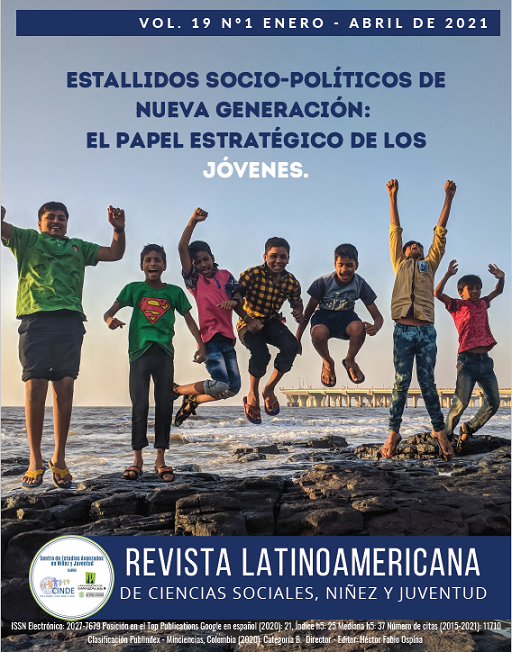
Prevención de riesgo psicosocial en adolescentes: el rol de los Centros de Día de Menores en España
Capella, S. & Navarro-Pérez, J. J.
(2021). ArticleRevista Latinoamericana De Ciencias Sociales, Niñez Y Juventud. Num.19(1), 1-22.
El artículo analiza la función de los Centros de Día de Menores (CDM) como recursos especializados en la intervención socioeducativa con adolescentes en riesgo. Se trata de una investigación cualitativa, en la que se han integrado diferentes técnicas con el fin de triangular evidencias objetivas. En el plano metodológico participó una muestra de 30 profesionales, implementando diferentes técnicas: entrevistas y grupos de discusión. Los datos obtenidos se codificaron y categorizaron. Los resultados destacan la especificidad de los CDM como recurso de proximidad en el proceso de socialización y de acompañamiento progresivo, individualizado y flexible de adolescentes en riesgo. Las...
El artículo analiza la función de los Centros de Día de Menores (CDM) como recursos especializados en la intervención socioeducativa con adolescentes en riesgo. Se trata de una investigación cualitativa, en la que se han integrado diferentes técnicas con el fin de triangular evidencias objetivas. En el plano metodológico participó una muestra de 30 profesionales, implementando diferentes técnicas: entrevistas y grupos de discusión. Los datos obtenidos se codificaron y categorizaron. Los resultados destacan la especificidad de los CDM como recurso de proximidad en el proceso de socialización y de acompañamiento progresivo, individualizado y flexible de adolescentes en riesgo. Las conclusiones inciden en la especialización del recurso en la atención a adolescentes que atraviesan procesos vitales complejos y en la consolidación del recurso como alternativa socioeducativa a la educación formal, utilizando en el territorio como generador de oportunidades.
Llegir més Ocultar19(1), 1-22.
DOI: https://doi.org/10.11600/rlcsnj.19.1.4293 -
Traditional Masculinity and Aggression in Adolescence: Its Relationship with Emotional Processes
Malonda-Vidal, E., Samper-García, P., Llorca-Mestre, A., Muñoz-Navarro, R., Mestre-Escrivá, V.
(2021). ArticleInternational Journal of Environmental Research and Public Health. Num.18(18):9802
Traditional masculinity includes norms that encourage many of the aggressive behaviors whereas traditional femininity emphasizes aggression very little. In addition, the lack of emotional regulation as well as a poor impulse control have been related to aggression and, in particular, with reactive and proactive aggression. The objective of this study is to examine the role of gender stereotypes (masculinity/femininity) in reactive and proactive aggression, through regulatory emotional self-efficacy and emotion regulation. A total of 390 adolescents participated in a longitudinal study in Valencia, Spain. Structural equations modeling (SEM) was employed to explore a two-wave longitudinal...
Traditional masculinity includes norms that encourage many of the aggressive behaviors whereas traditional femininity emphasizes aggression very little. In addition, the lack of emotional regulation as well as a poor impulse control have been related to aggression and, in particular, with reactive and proactive aggression. The objective of this study is to examine the role of gender stereotypes (masculinity/femininity) in reactive and proactive aggression, through regulatory emotional self-efficacy and emotion regulation. A total of 390 adolescents participated in a longitudinal study in Valencia, Spain. Structural equations modeling (SEM) was employed to explore a two-wave longitudinal model. The results show that femininity relates to reactive aggression through regulatory emotional self-efficacy and emotion regulation. This way, both emotional self-efficacy and emotional regulation mediate the relation between femininity and reactive aggression. Furthermore, reactive and proactive aggression relate positively and directly to masculinity and negatively to femininity. Therefore, violence prevention programs with adolescents should incorporate information to break down gender stereotypes and promote strategies to manage emotions. Such efforts may be helpful to reduce aggressive behaviors and violence.
Llegir més Ocultar -
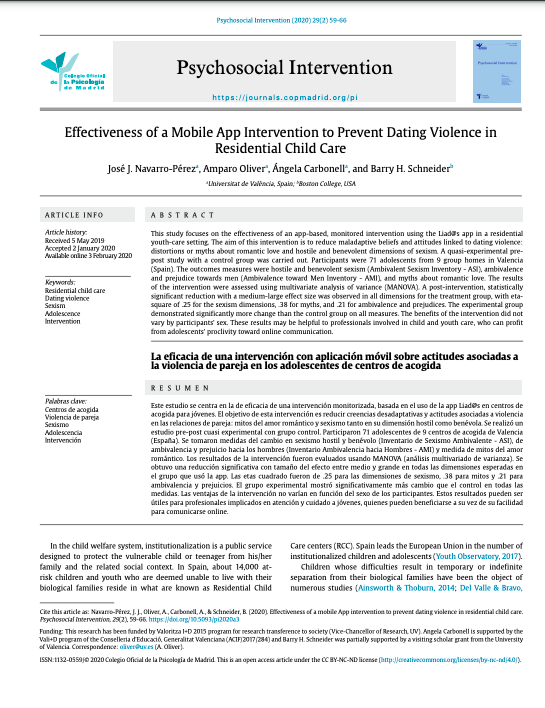
Effectiveness of a mobile app intervention to prevent dating violence in residential child care
Navarro-Pérez, J. J., Oliver, A., Carbonell, A., Schneider, B. H.
(2021). ArticlePsychosocial Intervention. Num.29(2):59-66
Este estudio se centra en la de eficacia de una intervención monitorizada, basada en el uso de la app Liad@s en centros de acogida para jóvenes. El objetivo de esta intervención es reducir creencias desadaptativas y actitudes asociadas a violencia en las relaciones de pareja: mitos del amor romántico y sexismo tanto en su dimensión hostil como benévola. Se realizó un estudio pre-post cuasi experimental con grupo control. Participaron 71 adolescentes de 9 centros de acogida de Valencia (España). Se tomaron medidas del cambio en sexismo hostil y benévolo (Inventario de Sexismo Ambivalente - ASI), de ambivalencia y prejuicio hacia los hombres (Inventario Ambivalencia hacia Hombres - AMI) y...
Este estudio se centra en la de eficacia de una intervención monitorizada, basada en el uso de la app Liad@s en centros de acogida para jóvenes. El objetivo de esta intervención es reducir creencias desadaptativas y actitudes asociadas a violencia en las relaciones de pareja: mitos del amor romántico y sexismo tanto en su dimensión hostil como benévola. Se realizó un estudio pre-post cuasi experimental con grupo control. Participaron 71 adolescentes de 9 centros de acogida de Valencia (España). Se tomaron medidas del cambio en sexismo hostil y benévolo (Inventario de Sexismo Ambivalente - ASI), de ambivalencia y prejuicio hacia los hombres (Inventario Ambivalencia hacia Hombres - AMI) y medida de mitos del amor romántico. Los resultados de la intervención fueron evaluados usando MANOVA (análisis multivariado de varianza). Se obtuvo una reducción significativa con tamaño del efecto entre medio y grande en todas las dimensiones esperadas en el grupo que usó la app. Las etas cuadrado fueron de .25 para las dimensiones de sexismo, .38 para mitos y .21 para ambivalencia y prejuicios. El grupo experimental mostró significativamente más cambio que el control en todas las medidas. Las ventajas de la intervención no varían en función del sexo de los participantes. Estos resultados pueden ser útiles para profesionales implicados en atención y cuidado a jóvenes, quienes pueden beneficiarse a su vez de su facilidad para comunicarse online.
Llegir més Ocultar DOI: 10.5093/pi2020a3 -
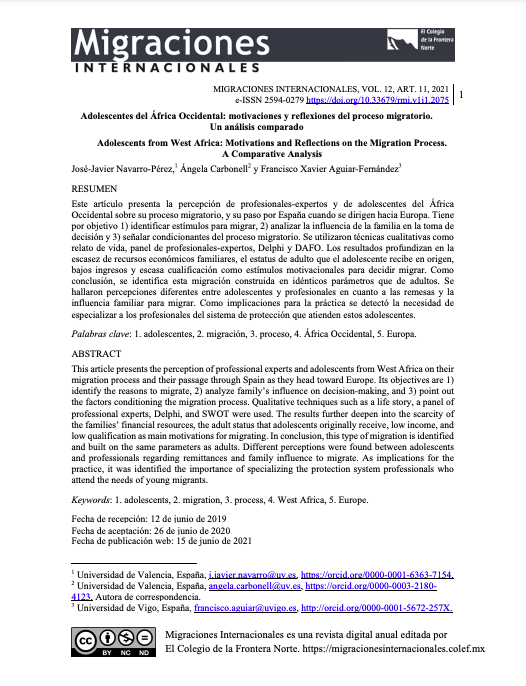
Adolescentes del África Occidental: motivaciones y reflexiones del proceso migratorio. Un análisis comparado
Navarro-Pérez, J. J., Carbonell, A., Aguiar-Fernández, F. X.
(2021). ArticleMigraciones Internacionales. Num.12(1):1-27.
Este artículo presenta la percepción de profesionales-expertos y de adolescentes del África Occidental sobre su proceso migratorio, y su paso por España cuando se dirigen hacia Europa. Tiene por objetivo 1) identificar estímulos para migrar, 2) analizar la influencia de la familia en la toma de decisión y 3) señalar condicionantes del proceso migratorio. Se utilizaron técnicas cualitativas como relato de vida, panel de profesionales-expertos, Delphi y DAFO. Los resultados profundizan en la escasez de recursos económicos familiares, el estatus de adulto que el adolescente recibe en origen, bajos ingresos y escasa cualificación como estímulos motivacionales para decidir migrar. Como...
Este artículo presenta la percepción de profesionales-expertos y de adolescentes del África Occidental sobre su proceso migratorio, y su paso por España cuando se dirigen hacia Europa. Tiene por objetivo 1) identificar estímulos para migrar, 2) analizar la influencia de la familia en la toma de decisión y 3) señalar condicionantes del proceso migratorio. Se utilizaron técnicas cualitativas como relato de vida, panel de profesionales-expertos, Delphi y DAFO. Los resultados profundizan en la escasez de recursos económicos familiares, el estatus de adulto que el adolescente recibe en origen, bajos ingresos y escasa cualificación como estímulos motivacionales para decidir migrar. Como conclusión, se identifica esta migración construida en idénticos parámetros que de adultos. Se hallaron percepciones diferentes entre adolescentes y profesionales en cuanto a las remesas y la influencia familiar para migrar. Como implicaciones para la práctica se detectó la necesidad de especializar a los profesionales del sistema de protección que atienden estos adolescentes.
Llegir més Ocultar DOI: 10.33679/rmi.v1i1.2075 -
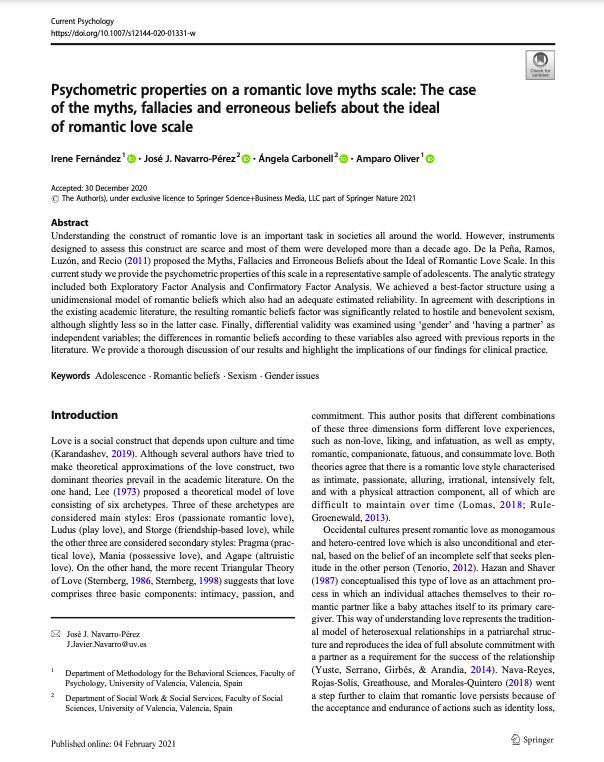
Psychometric properties on a romantic love myths scale: The case of the myths, fallacies and erroneous beliefs about the ideal of romantic love scale
Fernández, I., Navarro-Pérez, J. J., Carbonell, Á., Oliver, A.
(2021). ArticleCurrent Psychology: A Journal for Diverse Perspectives on Diverse Psychological Issues. Num.1-11
Understanding the construct of romantic love is an important task in societies all around the world. However, instruments designed to assess this construct are scarce and most of them were developed more than a decade ago. De la Peña, Ramos, Luzón, and Recio (2011) proposed the Myths, Fallacies and Erroneous Beliefs about the Ideal of Romantic Love Scale. In this current study we provide the psychometric properties of this scale in a representative sample of adolescents. The analytic strategy included both Exploratory Factor Analysis and Confirmatory Factor Analysis. We achieved a best-factor structure using a unidimensional model of romantic beliefs which also had an adequate estimated...
Understanding the construct of romantic love is an important task in societies all around the world. However, instruments designed to assess this construct are scarce and most of them were developed more than a decade ago. De la Peña, Ramos, Luzón, and Recio (2011) proposed the Myths, Fallacies and Erroneous Beliefs about the Ideal of Romantic Love Scale. In this current study we provide the psychometric properties of this scale in a representative sample of adolescents. The analytic strategy included both Exploratory Factor Analysis and Confirmatory Factor Analysis. We achieved a best-factor structure using a unidimensional model of romantic beliefs which also had an adequate estimated reliability. In agreement with descriptions in the existing academic literature, the resulting romantic beliefs factor was significantly related to hostile and benevolent sexism, although slightly less so in the latter case. Finally, differential validity was examined using ‘gender’ and ‘having a partner’ as independent variables; the differences in romantic beliefs according to these variables also agreed with previous reports in the literature. We provide a thorough discussion of our results and highlight the implications of our findings for clinical practice.
Llegir més Ocultar DOI: 10.1007/s12144-020-01331-w -
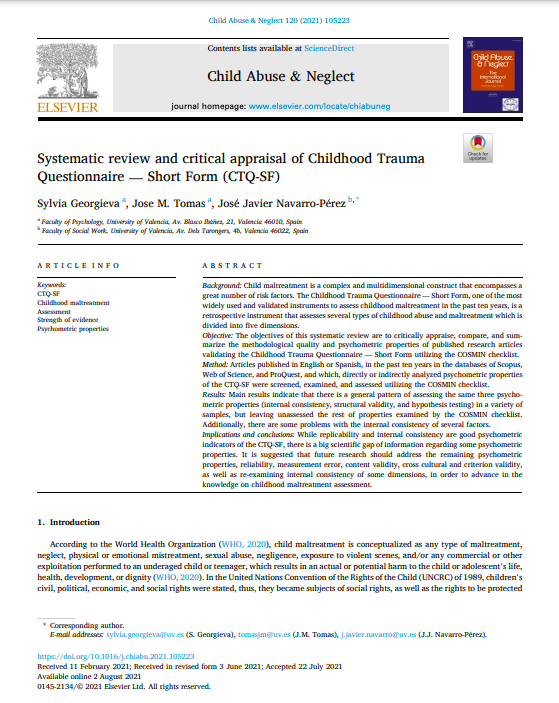
Systematic review and critical appraisal of Childhood Trauma Questionnaire — Short Form (CTQ-SF)
Georgieva, S., Tomás, J. M., Navarro-Pérez, J. J.
(2021). ArticleChild Abuse & Neglect. Num.120:105223.
Background: Child maltreatment is a complex and multidimensional construct that encompasses a great number of risk factors. The Childhood Trauma Questionnaire — Short Form, one of the most widely used and validated instruments to assess childhood maltreatment in the past ten years, is a retrospective instrument that assesses several types of childhood abuse and maltreatment which is divided into five dimensions. Objective: The objectives of this systematic review are to critically appraise, compare, and summarize the methodological quality and psychometric properties of published research articles validating the Childhood Trauma Questionnaire — Short Form utilizing the COSMIN...
Background: Child maltreatment is a complex and multidimensional construct that encompasses a great number of risk factors. The Childhood Trauma Questionnaire — Short Form, one of the most widely used and validated instruments to assess childhood maltreatment in the past ten years, is a retrospective instrument that assesses several types of childhood abuse and maltreatment which is divided into five dimensions. Objective: The objectives of this systematic review are to critically appraise, compare, and summarize the methodological quality and psychometric properties of published research articles validating the Childhood Trauma Questionnaire — Short Form utilizing the COSMIN checklist. Method: Articles published in English or Spanish, in the past ten years in the databases of Scopus, Web of Science, and ProQuest, and which, directly or indirectly analyzed psychometric properties of the CTQ-SF were screened, examined, and assessed utilizing the COSMIN checklist. Results: Main results indicate that there is a general pattern of assessing the same three psychometric properties (internal consistency, structural validity, and hypothesis testing) in a variety of samples, but leaving unassessed the rest of properties examined by the COSMIN checklist. Additionally, there are some problems with the internal consistency of several factors. Implications and conclusions: While replicability and internal consistency are good psychometric indicators of the CTQ-SF, there is a big scientific gap of information regarding some psychometric properties. It is suggested that future research should address the remaining psychometric properties, reliability, measurement error, content validity, cross cultural and criterion validity, as well as re-examining internal consistency of some dimensions, in order to advance in the knowledge on childhood maltreatment assessment.
Llegir més Ocultar DOI: 10.1016/j.chiabu.2021.105223 -
Examining the predictors of prosocial behavior in young offenders and nonoffenders
Samper P, Llorca A, Malonda E, Mestre MV.
(2021). ArticleInternational Journal of Behavioral Development. Num.45(4):299-309
Research on young offenders has primarily focused on identifying predictors of the maladaptive, aggressive behavior; there is a scarcity of evidence on factors that relate to prosocial behavior in these adolescents. The current study examined the link from parenting, emotional instability, and prosocial reasoning to prosocial behavior, while also examining the mediating roles of empathic concern (EC) and perspective taking (PT) in a sample of Spanish adolescent offenders compared to a sample of nonoffenders. Participants were 440 adolescents: 220 young offenders residing in four Youth Detention Centres of Valencia (67.3% men) and 220 enrolled in public and private schools within the...
Research on young offenders has primarily focused on identifying predictors of the maladaptive, aggressive behavior; there is a scarcity of evidence on factors that relate to prosocial behavior in these adolescents. The current study examined the link from parenting, emotional instability, and prosocial reasoning to prosocial behavior, while also examining the mediating roles of empathic concern (EC) and perspective taking (PT) in a sample of Spanish adolescent offenders compared to a sample of nonoffenders. Participants were 440 adolescents: 220 young offenders residing in four Youth Detention Centres of Valencia (67.3% men) and 220 enrolled in public and private schools within the metropolitan area of Valencia (65.9% men). The two subsamples were similar in age (15−18 years), gender, and social class. Analyses show differences in mother’s permissiveness with empathy (PT and EC), in emotional instability and internalized reasoning with PT in predicting prosocial behavior in offenders and nonoffenders adolescents. EC and PT are significative and positively related to prosocial behavior in both groups. These findings have implications for prevention and reeducation interventions oriented to social reinsertion of adolescent offenders and the development of family and social counseling programs that favor adaptive behavior.
Llegir més Ocultar DOI: 10.1177/0165025421995930 -
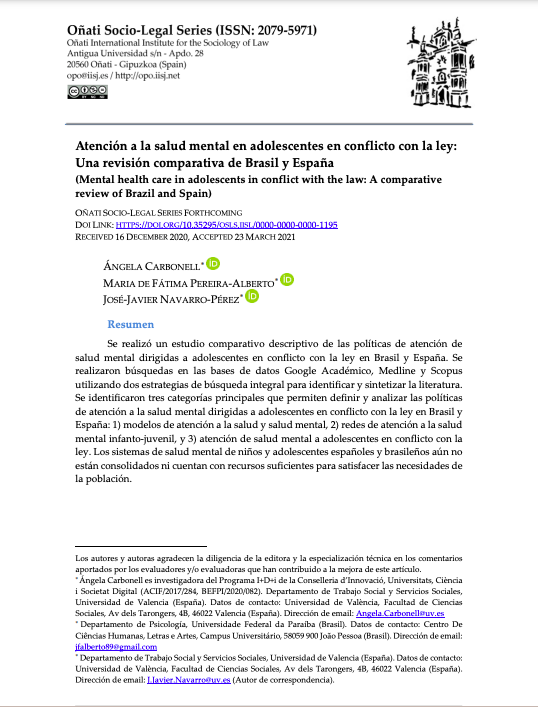
Atención a la salud mental en adolescentes en conflicto con la ley: Una revisión comparativa de Brasil y España
Carbonell, A., Pereira-Alberto, M. F., Navarro-Pérez, J. J.
(2021). ArticleOñati Socio Legal Series. Num.2021:1-24.
Se realizó un estudio comparativo descriptivo de las políticas de atención de salud mental dirigidas a adolescentes en conflicto con la ley en Brasil y España. Se realizaron búsquedas en las bases de datos Google Académico, Medline y Scopus utilizando dos estrategias de búsqueda integral para identificar y sintetizar la literatura. Se identificaron tres categorías principales que permiten definir y analizar las políticas de atención a la salud mental dirigidas a adolescentes en conflicto con la ley en Brasil y España: 1) modelos de atención a la salud y salud mental, 2) redes de atención a la salud mental infanto-juvenil, y 3) atención de salud mental a adolescentes en conflicto con la ley....
Se realizó un estudio comparativo descriptivo de las políticas de atención de salud mental dirigidas a adolescentes en conflicto con la ley en Brasil y España. Se realizaron búsquedas en las bases de datos Google Académico, Medline y Scopus utilizando dos estrategias de búsqueda integral para identificar y sintetizar la literatura. Se identificaron tres categorías principales que permiten definir y analizar las políticas de atención a la salud mental dirigidas a adolescentes en conflicto con la ley en Brasil y España: 1) modelos de atención a la salud y salud mental, 2) redes de atención a la salud mental infanto-juvenil, y 3) atención de salud mental a adolescentes en conflicto con la ley. Los sistemas de salud mental de niños y adolescentes españoles y brasileños aún no están consolidados ni cuentan con recursos suficientes para satisfacer las necesidades de la población.
Llegir més Ocultar DOI: 10.35295/OSLS.IISL/0000-0000-0000-1195






